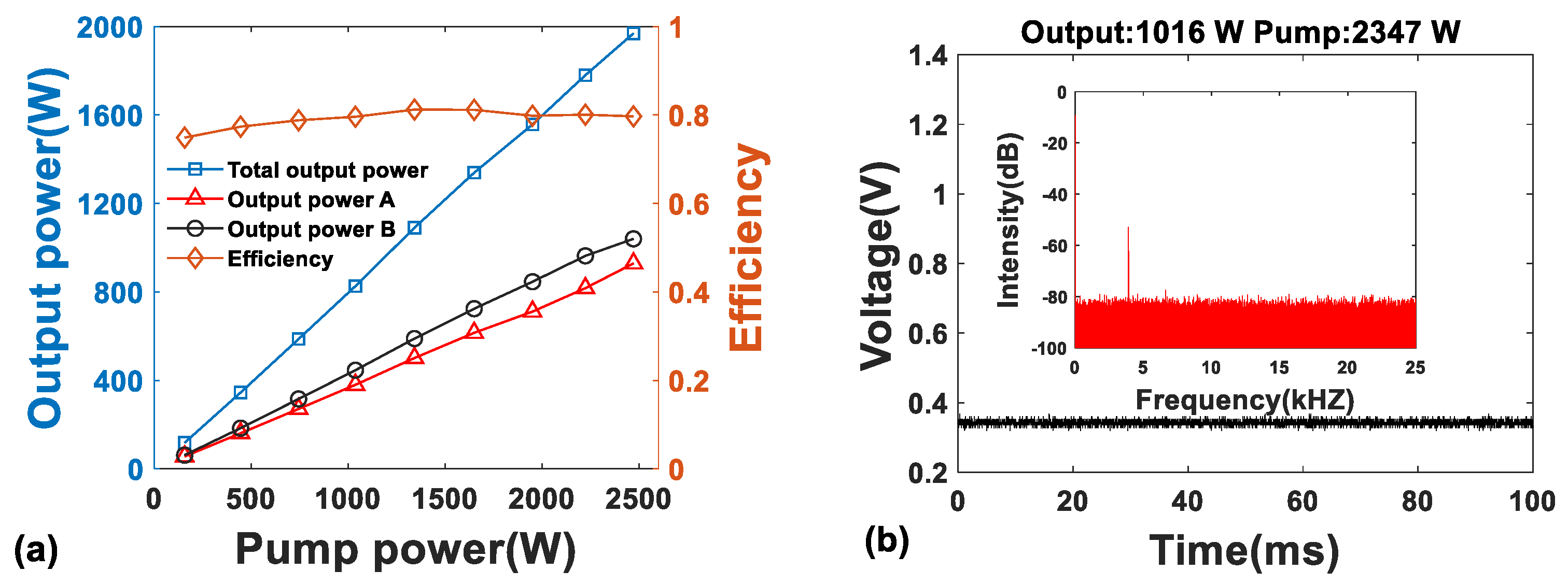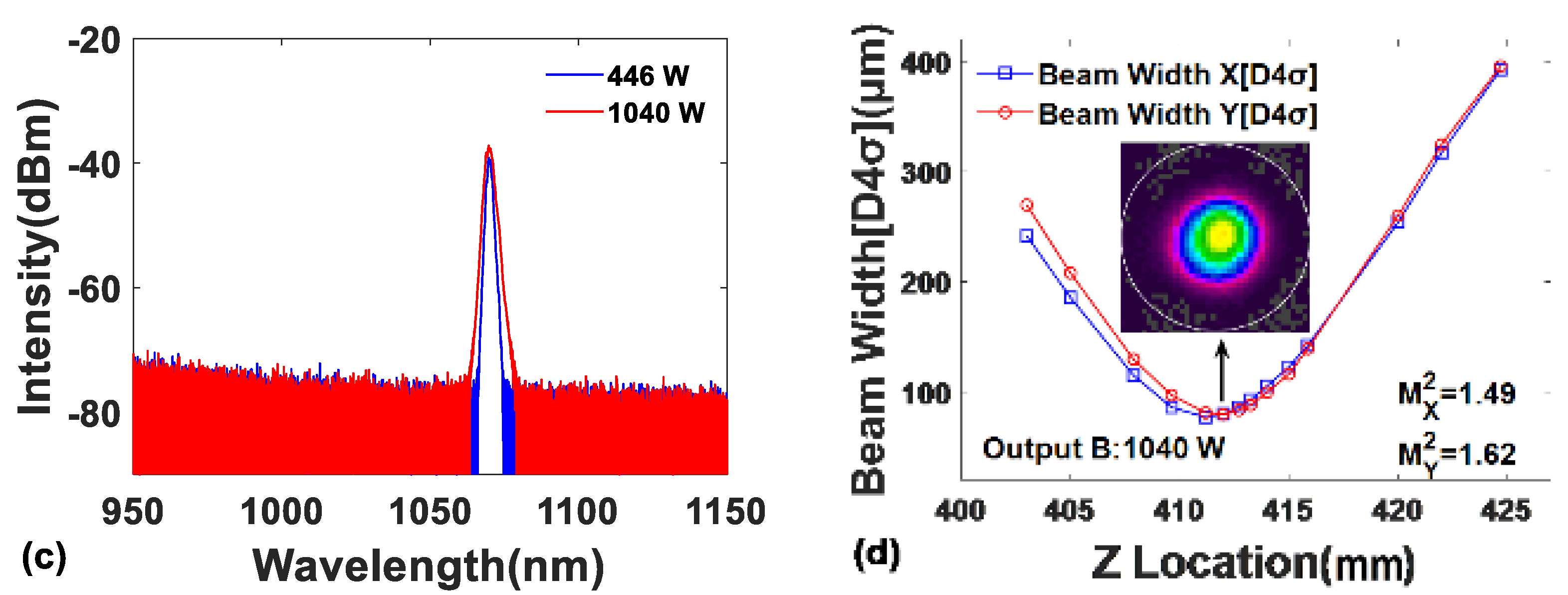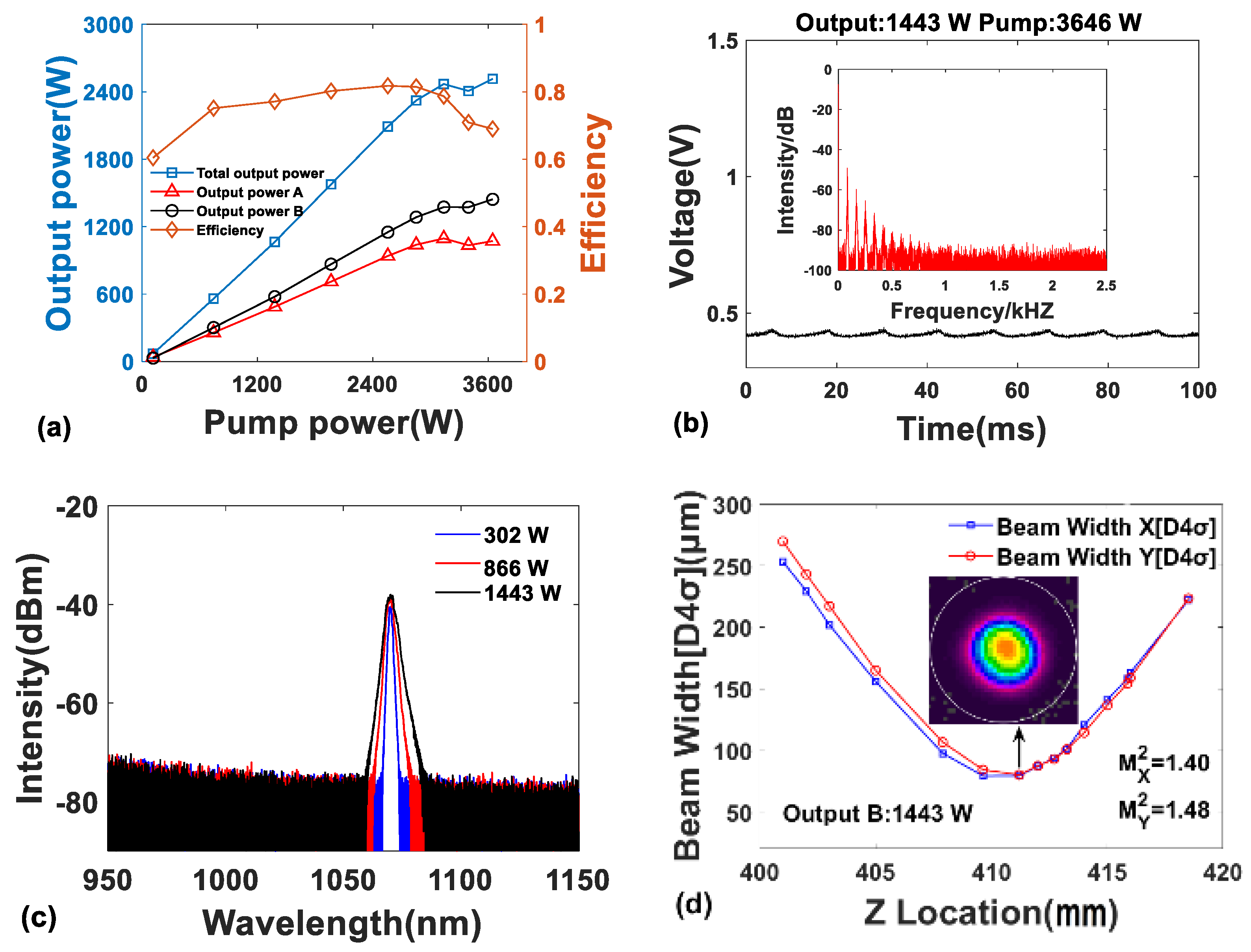Research of Transverse Mode Instability in High-Power Bidirectional Output Yb-Doped Fiber Laser Oscillators
Abstract
1. Introduction
2. Experimental Setup
3. Results and Discussion
3.1. TMI Characteristics of the Bidirectional Output Fiber Laser Oscillator Pumped by 976 nm LDs
3.2. TMI Threshold of the Bidirectional Output Fiber Laser Oscillator Improvement Employing 981 nm LDs
3.3. Comparison of TMI Effect in Bidirectional and Unidirectional Output Fiber Laser Oscillators
4. Conclusions
Author Contributions
Funding
Data Availability Statement
Acknowledgments
Conflicts of Interest
References
- Richardson, D.J.; Nilsson, J.; Clarkson, W.A. High power fiber lasers: Current status and future perspectives. J. Opt. Soc. Am. B 2010, 27, B63–B92. [Google Scholar] [CrossRef]
- Zervas, M.N.; Codemard, C.A. High Power Fiber Lasers: A Review. IEEE J. Sel. Top. Quant. 2014, 20, 219–241. [Google Scholar] [CrossRef]
- Zervas, M.N. High power ytterbium-doped fiber lasers—Fundamentals and applications. Int. J. Mod. Phys. B 2014, 28, 199–493. [Google Scholar]
- Song, K.; Yang, Y.; Zhang, X. Industrial 1.5 kW single-stage end-pumped fiber laser. Opt. Laser Technol. 2019, 111, 537–540. [Google Scholar] [CrossRef]
- Ye, Y.; Yang, B.; Wang, P.; Zeng, L.; Xi, X.; Shi, C.; Zhang, H.; Wang, X.; Zhou, P.; Xu, X. Industrial 6 kW high-stability single-stage all-fiber laser oscillator based on conventional large mode area ytterbium-doped fiber. Laser Phys. Int. J. Devoted Theor. Exp. Laser Res. Appl. 2021, 31, 035104. [Google Scholar] [CrossRef]
- Wang, Y.; Kitahara, R.; Kiyoyama, W.; Shirakura, Y.; Kurihara, T.; Nakanishi, Y.; Yamamoto, T.; Nakayama, M.; Ikoma, S.; Shima, K. 8-kW single-stage all-fiber Yb-doped fiber laser with a BPP of 0.50 mm-mrad. In Proceedings of the Fiber Lasers XVII: Technology and Systems, San Francisco, CA, USA, 3–6 February 2020. [Google Scholar]
- Krmer, R.G.; Mller, F.; Matzdorf, C.; Goebel, T.A.; Nolte, S. Extremely robust femtosecond written fiber Bragg gratings for ytterbium doped fiber oscillator with 5 kW output power. Opt. Lett. 2020, 45, 1447–1450. [Google Scholar] [CrossRef] [PubMed]
- Ballato, J.; Mashiko, Y.; Nguyen, H.K.; Kashiwagi, M.; Kitabayashi, T.; Shima, K.; Tanaka, D. 2 kW single-mode fiber laser with 20-m long delivery fiber and high SRS suppression. In Proceedings of the Fiber Lasers XIII: Technology, Systems, & Applications, San Francisco, CA, USA, 30 June 2016. [Google Scholar]
- Robin, C.A.; Hartl, I.; Ikoma, S.; Nguyen, H.K.; Kashiwagi, M.; Uchiyama, K.; Shima, K.; Tanaka, D. 3 kW single stage all-fiber Yb-doped single-mode fiber laser for highly reflective and highly thermal conductive materials processing. Proc. SPIE 2017, 83, 100830Y. [Google Scholar]
- Ikoma, S.; Uchiyama, K.; Takubo, Y.; Kashiwagi, M.; Tanaka, D. 5-kW single stage all-fiber Yb-doped single-mode fiber laser for materials processing. In Proceedings of the Fiber Lasers XV: Technology and Systems, San Francisco, CA, USA, 26 February 2018. [Google Scholar]
- Wan, Y.; Wang, X.; Shi, C.; Zhang, H.; Yang, B.; Xi, X.; Wang, P. Theoretical research on optimizing the output power of double-ended output fiber laser. In Proceedings of the National Laser Conference; National Conference on Laser Technology and Optoelectronics, Shanghai, China, 2 December 2020. [Google Scholar]
- Jiang, J.M.; Chen, X.J.; Gao, Y.X.; Liu, M.; Luo, Z.C. Bidirectional ultrahigh-repetition-rate ultrafast fiber laser. Opt. Laser Technol. 2021, 142, 107196. [Google Scholar] [CrossRef]
- Hu, G.; Dong, M.; Chen, K.; Wang, Z.; Niu, H.; Zhu, L. Tunable multidimensional multiplexed Q-switched pulse outputs from a linear fiber laser with a bidirectional loop. Opt. Laser Technol. 2021, 141, 107138. [Google Scholar] [CrossRef]
- Cui, W.; Zhou, X.; Bi, M.; Yang, G.; Hu, M.; Wang, T. Switchable generation of multi-wavelength continuous wave and square-wave pluses in a bidirectional Erbium-doped fiber laser. Opt. Laser Technol. 2021, 143, 1–6. [Google Scholar] [CrossRef]
- Liu, C.H.; Ehlers, B.; Doerfel, F.; Heinemann, S.; Carter, A.; Tankala, K.; Farroni, J.; Galvanauskas, A. 810 W continuous-wave and single-transverse-mode fibre laser using 20 μm core Yb-doped double-clad fibre. Electron. Lett. 2004, 40, 1471–1472. [Google Scholar] [CrossRef]
- Zhong, P.; Wang, L.; Yang, B.; Zhang, H.; Xi, X.; Wang, P.; Wang, X. 2 × 2 kW near-single-mode bidirectional high-power output from a single-cavity monolithic fiber laser. Opt. Lett. 2022, 47, 2806–2809. [Google Scholar] [CrossRef] [PubMed]
- Liu, J.; Zeng, L.; Wang, P.; Yang, B.; Xi, X.; Shi, C.; Zhang, H.; Wang, X.; Xi, F. A Novel Bidirectional Output Oscillating-Amplifying Integrated Fiber Laser With 2 Ports × 2 kW Level Near-Single-Mode Output. IEEE Photonics J. 2023, 15, 1–9. [Google Scholar] [CrossRef]
- Eidam, T.; Hanf, S.; Seise, E.; Andersen, T.V.; Gabler, T.; Wirth, C.; Schreiber, T.; Limpert, J.; Tünnermann, A. Femtosecond fiber CPA system emitting 830 W average output power. Opt. Lett. 2010, 35, 94–96. [Google Scholar] [CrossRef] [PubMed]
- Jauregui, C.; Eidam, T.; Otto, H.; Stutzki, F.; Jansen, F.; Limpert, J.; Tünnermann, A. Physical origin of mode instabilities in high-power fiber laser systems. Opt. Express 2012, 20, 12912–12925. [Google Scholar] [CrossRef]
- Jauregui, C.; Eidam, T.; Otto, H.; Stutzki, F.; Jansen, F.; Limpert, J.; Tünnermann, A. Temperature-induced index gratings and their impact on mode instabilities in high-power fiber laser systems. Opt. Express 2012, 20, 440–451. [Google Scholar] [CrossRef]
- Wang, J.; Liu, Y.; Li, M.; Feng, X.; Chu, Q.; Zhang, C.; Gao, C.; Tao, R.; Lin, H.; Jing, F. Ten-year review and prospect on mode instability research of fiber lasers. High Power Laser Part. Beams 2020, 32, 43–54. [Google Scholar]
- Tao, R.; Ma, P.; Wang, X.; Zhou, P.; Liu, Z. Study of Wavelength Dependence of Mode Instability Based on a Semi-Analytical Model. IEEE J. Quantum Electron. Publ. IEEE Quantum Electron. Appl. Soc. 2015, 51, 1–6. [Google Scholar]
- Otto, H.; Modsching, N.; Jauregui, C.; Limpert, J.; Tünnermann, A. Wavelength dependence of maximal diffraction-limited output power of fiber lasers. In Proceedings of the International Society for Optics and Photonics, Shanghai, China, 16–21 November 2014. [Google Scholar]
- Beier, F.; Hupel, C.; Nold, J.; Kuhn, S.; Hein, S.; Ihring, J.; Sattler, B.; Haarlammert, N.; Schreiber, T.; Eberhardt, R. Narrow linewidth, single mode 3 kW average power from a directly diode pumped ytterbium-doped low NA fiber amplifier. Opt. Express 2016, 24, 6011–6020. [Google Scholar] [CrossRef]
- Beier, F.; Hupel, C.; Kuhn, S.; Hein, S.; Tünnermann, A. Single mode 4.3 kW output power from a diode-pumped Yb-doped fiber amplifier. Opt. Express 2017, 25, 14892–14899. [Google Scholar] [CrossRef]
- Li, Z.; Huang, Z.; Xiang, X.; Liang, X.; Lin, H.; Xu, S.; Yang, Z.; Wang, J.; Jing, F. Experimental demonstration of transverse mode instability enhancement by a counter-pumped scheme in a 2 kW all-fiberized laser. Photonics Res. 2017, 5, 77–81. [Google Scholar] [CrossRef]
- Wang, Y.; Yang, B.; Xi, M.; Zhang, H.; Ye, Y.; Wang, X. Transverse mode instability effect of fiber lasers with different pump wavelengths. Infrared Laser Eng. 2021, 51, 1–8. [Google Scholar]
- Otto, H.; Stutzki, F.; Jansen, F.; Eidam, T.; Tünnermann, A. Temporal dynamics of mode instabilities in high-power fiber lasers and amplifiers. Opt. Express 2012, 20, 15710–15722. [Google Scholar] [CrossRef] [PubMed]
- Wan, Y.; Xi, X.; Yang, B.; Zhang, H.; Wang, X. Enhancement of TMI Threshold in Yb-Doped Fiber Laser by Optimizing Pump Wavelength. IEEE Photonics Technol. Lett. 2021, 33, 656–659. [Google Scholar] [CrossRef]






| Pump Distribution | A-End | B-End | ||
|---|---|---|---|---|
| Pump Power (W) | TMI Threshold (W) | Pump Power (W) | TMI Threshold (W) | |
| A-pump | 583 | 184 | 583 | 276 |
| B-pump | 760 | 321 | 711 | 262 |
| Bi-pump | 2248 | 842 | 2347 | 1016 |
| Pump Distribution | A-End | B-End | ||
|---|---|---|---|---|
| Pump Power (W) | TMI Threshold (W) | Pump Power (W) | TMI Threshold (W) | |
| A-pump | 1247 | 385 | 1224 | 584 |
| B-pump | 1908 | 805 | 1886 | 692 |
| Bi-pump | 3596 | 1046 | 3646 | 1443 |
| Structure | Pump Distribution | Pump Power (W) | TMI Threshold (W) |
|---|---|---|---|
| Unidirectional output | Co-pump | 1508 | 1037 |
| Counter-pump | 3907 | 2628 | |
| Bidirectional pump | 5795 | 4000 | |
| Bidirectional output | Bidirectional pump | 3646 | 2515 |
Disclaimer/Publisher’s Note: The statements, opinions and data contained in all publications are solely those of the individual author(s) and contributor(s) and not of MDPI and/or the editor(s). MDPI and/or the editor(s) disclaim responsibility for any injury to people or property resulting from any ideas, methods, instructions or products referred to in the content. |
© 2023 by the authors. Licensee MDPI, Basel, Switzerland. This article is an open access article distributed under the terms and conditions of the Creative Commons Attribution (CC BY) license (https://creativecommons.org/licenses/by/4.0/).
Share and Cite
Li, F.; Ding, X.; Wang, P.; Yang, B.; Xi, X.; Zhang, H.; Wang, X.; Chen, J. Research of Transverse Mode Instability in High-Power Bidirectional Output Yb-Doped Fiber Laser Oscillators. Photonics 2023, 10, 912. https://doi.org/10.3390/photonics10080912
Li F, Ding X, Wang P, Yang B, Xi X, Zhang H, Wang X, Chen J. Research of Transverse Mode Instability in High-Power Bidirectional Output Yb-Doped Fiber Laser Oscillators. Photonics. 2023; 10(8):912. https://doi.org/10.3390/photonics10080912
Chicago/Turabian StyleLi, Fengchang, Xinyi Ding, Peng Wang, Baolai Yang, Xiaoming Xi, Hanwei Zhang, Xiaolin Wang, and Jinbao Chen. 2023. "Research of Transverse Mode Instability in High-Power Bidirectional Output Yb-Doped Fiber Laser Oscillators" Photonics 10, no. 8: 912. https://doi.org/10.3390/photonics10080912
APA StyleLi, F., Ding, X., Wang, P., Yang, B., Xi, X., Zhang, H., Wang, X., & Chen, J. (2023). Research of Transverse Mode Instability in High-Power Bidirectional Output Yb-Doped Fiber Laser Oscillators. Photonics, 10(8), 912. https://doi.org/10.3390/photonics10080912






